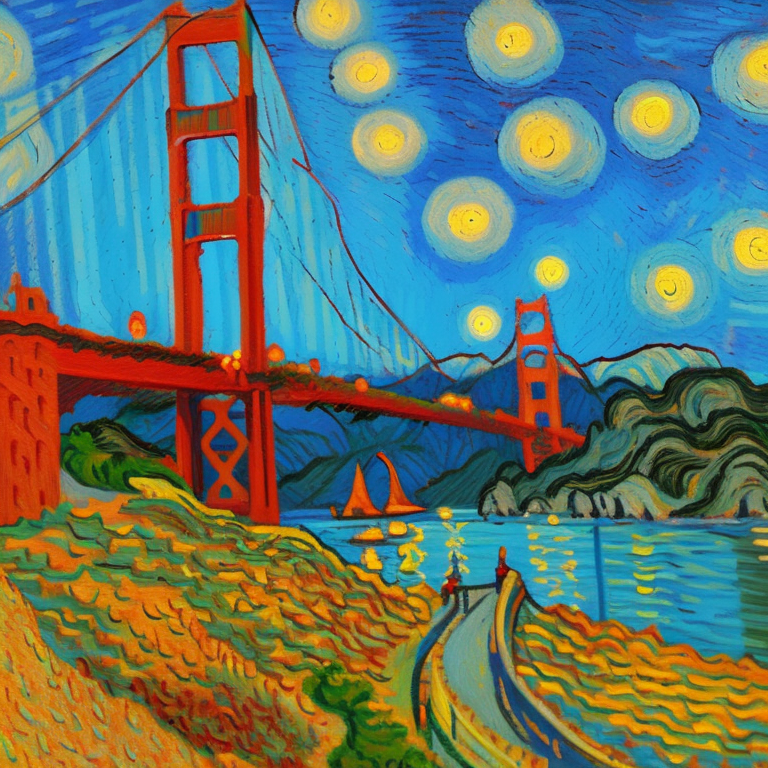Efficient image generation with Stable Diffusion models and AITemplate using AMD GPUs#

24 Jan, 2024 by .
Stable Diffusion has emerged as a groundbreaking advancement in the field of image generation, empowering users to translate text descriptions into captivating visual output.
At the heart of Stable Diffusion lies a unique approach known as diffusion modeling. This process takes an existing image and gradually introduces noise until it becomes unrecognizable in the forward pass. Then, guided by text prompts, the model meticulously reverses this process, gradually refining the noisy image back into a coherent and meaningful representation that aligns with the textual input. This innovative technique enables Stable Diffusion to generate images with remarkable fidelity and adherence to the text input.
By carefully controlling the diffusion process and incorporating textual guidance, the model effectively captures the essence of the text, translating abstract concepts into vivid visual representations.
The versatility of Stable Diffusion extends beyond text-to-image generation. Its capabilities encompass a range of image manipulation tasks, including image-to-image translation and inpainting.
Image-to-image translation involves transforming one image into another while preserving essential features, such as style, color palette, and structure.
Inpainting focuses on restoring damaged or incomplete images by filling in missing or corrupted regions with plausible and consistent details.
AITemplate plays a crucial role in enhancing the performance and efficiency of Stable Diffusion. This open-source Python framework transforms AI models into high-performance C++ GPU template code for accelerating inference. It operates by analyzing the model architecture, then fuses and optimizes layers and operations specific to that architecture. This allows AITemplate to generate highly optimized code that leverages the capabilities of the target hardware, particularly AMD GPUs.
Through its support of AMD MatrixCore architecture, AITemplate unlocks additional performance gains via the efficient utilization of hardware resources. This translates to faster inference times, smoother image generation, and a more streamlined and user-friendly experience.
In this blog, we use pre-trained Stable Diffusion models for text-to-image generation with AITemplate on AMD GPUs. You can also independently explore the steps for image-to-image generation and inpainting.
Setting up the running environment#
You can run Stable Diffusion models on AMD GPUs after installing ROCm and its compatible packages.
For this blog, we tested our code snippets on ROCm 5.7, Ubuntu 22.04, Python 3.10, and Pytorch 2.0.1. For convenience, you can directly pull and run the Docker container in your Linux system using the following code:
docker pull rocm/pytorch
docker run -it --ipc=host --network=host --device=/dev/kfd --device=/dev/dri \
--group-add video --cap-add=SYS_PTRACE --security-opt seccomp=unconfined \
--name=sdxl rocm/pytorch:rocm5.7_ubuntu22.04_py3.10_pytorch_2.0.1 /bin/bash
You must install essential Python packages (notably AITemplate) once you are in the running Docker (or other appropriate PyTorch/ROCm) environment.
Note that the AITemplate package on Meta Incubator may not be compatible with ROCm. We recommend cloning the repository from ROCmSoftwarePlatform and installing the package using this code:
git clone --recursive --branch ds-blog https://github.com/ROCmSoftwarePlatform/AITemplate
cd AITemplate/python
python setup.py bdist_wheel
pip install dist/aitemplate-*.whl
To install other necessary packages, use:
pip3 install diffusers transformers click accelerate
Generating images with a text prompt#
First, download the diffusers pipeline files. The model is
stabilityai/stable-diffusion-2-1, which is
fine-tuned from stable-diffusion-2
(768-v-ema.ckpt). The resolution of the generated image is 768 x 768 px.
cd ../examples/05_stable_diffusion/
python3 scripts/download_pipeline.py \
--model-name "stabilityai/stable-diffusion-2-1"
Then, compile the model.
python3 scripts/compile.py --width 768 --height 768
You can test the complied model by supplying it with different prompts. For example:
python3 scripts/demo_alt.py --hf-hub-or-path stabilityai/stable-diffusion-2-1 --width 768 --height 768 \
--prompt "A Van Gogh-inspired landscape painting of Golden Gate Bridge, capturing the swirling brushstrokes\
and vibrant colors characteristic of the artist's style."
The generated image is saved in the AITemplate/examples/05_stable_diffusion/ folder as
example_ait.png.
The above Van Gogh-inspired prompt generates  .
.
Here are some prompt suggestions you can try:
“The house in the forest, dark night, leaves in the air, fluorescent mushrooms, clear focus, very coherent, very detailed, contrast, vibrant, digital painting”
“A photorealistic portrait of a young woman with flowing red hair and piercing green eyes, smiling warmly against a backdrop of lush greenery.”
“A classic oil painting depicting a grand banquet scene, with nobles and ladies adorned in exquisite attire feasting under a chandelier’s soft glow.”
“A pixel art rendition of a bustling cyberpunk cityscape, neon lights illuminating skyscrapers and holographic advertisements casting a vibrant glow.”